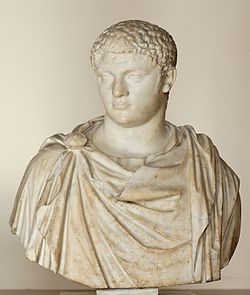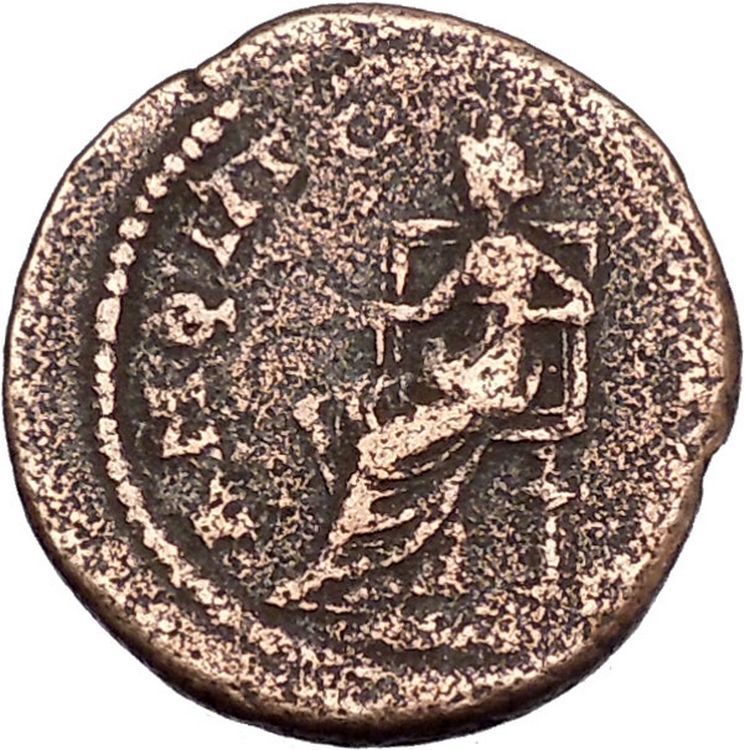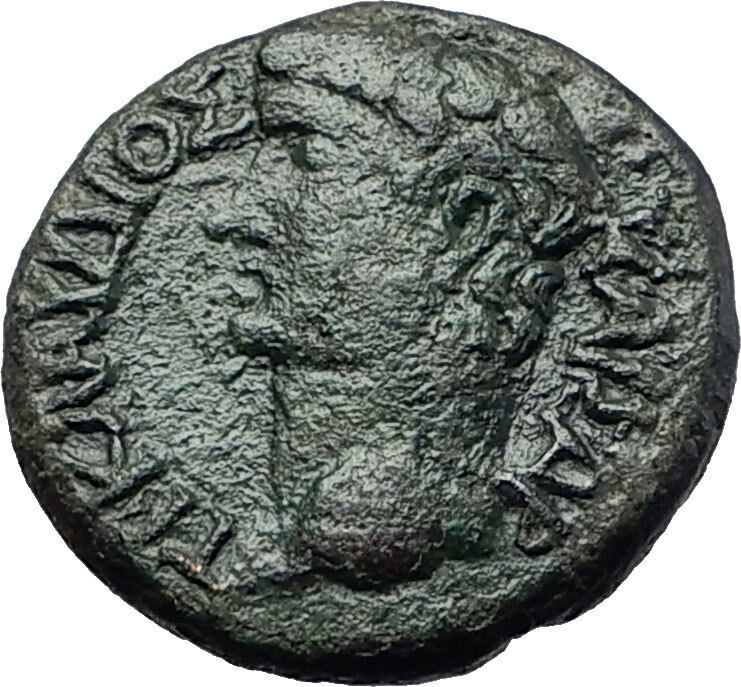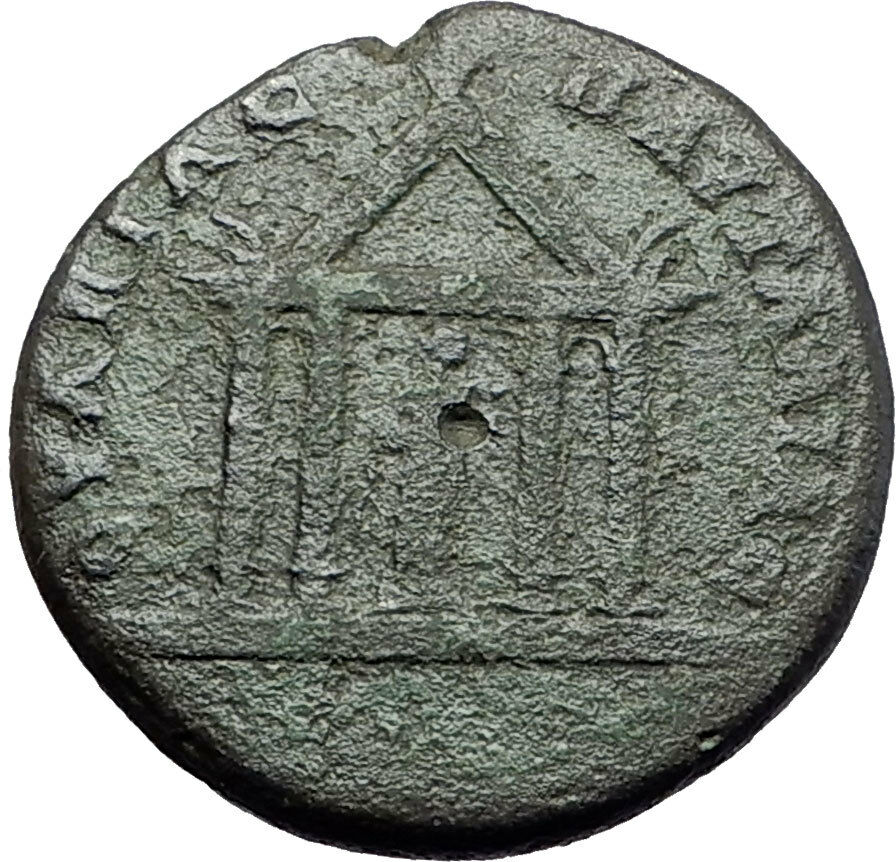|
Geta – Roman Caesar: 198-209 A.D. –
Roman Emperor: 209-211 A.D. –
Bronze 33mm (16.85 grams)
mint of
Mylasa in Caria
Reference: Akarca 90; BMC 38; SNG Copenhagen 437; SNG von Aulock 2630
ΠO CEΠTIMIOC ΓETA C KAIC, bare-headed, draped and cuirassed bust right.
MYΛA-CEΩN, Facing cult statue of Zeus Labraundos within tetrastyle temple with
wreath in pediment.
You are bidding on the exact item pictured,
provided with a Certificate of Authenticity and Lifetime Guarantee of
Authenticity.
In the
ancient Greek
religion, Zeus was the
“Father of Gods and men” (πατὴρ ἀνδρῶν τε θεῶν
τε)
who ruled the Olympians of
Mount Olympus
as a father ruled the family. He was the
god of sky
and
thunder
in
Greek mythology
.
His
Roman
counterpart is
Jupiter
and
Etruscan
counterpart is Tinia
.![The Jupiter de Smyrne, discovered in Smyrna in 1680[1]](https://upload.wikimedia.org/wikipedia/commons/thumb/c/c8/Jupiter_Smyrna_Louvre_Ma13.jpg/200px-Jupiter_Smyrna_Louvre_Ma13.jpg)
Zeus was the child of
Cronus
and
Rhea
,
and the youngest of his siblings. In most traditions he was married to
Hera, although, at the
oracle of Dodona
,
his consort was
Dione
:
according to the Iliad
,
he is the father of
Aphrodite
by Dione. He is known for his erotic escapades. These resulted in many godly and
heroic offspring, including
Athena
,
Apollo
and Artemis
,
Hermes
,
Persephone
(by Demeter
),
Dionysus
,
Perseus
,
Heracles
,
Helen of Troy
,
Minos
,
and the Muses
(by Mnemosyne
);
by Hera, he is usually said to have fathered
Ares,
Hebe
and Hephaestus
.
As
Walter Burkert
points out in his book, Greek Religion, “Even the gods who are not his
natural children address him as Father, and all the gods rise in his presence.”
For the Greeks, he was the
King of the Gods
,
who oversaw the universe. As
Pausanias
observed, “That Zeus is king in heaven is a saying common to all men”. In
Hesiod’s Theogony
Zeus assigns the various gods their roles. In the Homeric Hymns he is
referred to as the chieftain of the gods.
His symbols are the
thunderbolt
,
eagle
,
bull
,
and oak
.
In addition to his Indo-European inheritance, the classical “cloud-gatherer”
also derives certain iconographic traits from the cultures of the
Ancient Near East
,
such as the
scepter
.
Zeus is frequently depicted by Greek artists in one of two poses: standing,
striding forward, with a thunderbolt leveled in his raised right hand, or seated
in majesty.
Milas (ancient Mylasa Μύλασα) is an
ancient city and the seat of the district of the same name in
Muğla Province
in southwestern
Turkey
. The city commands a region with an
active economy, and the region is very rich in history and its remains, the
whole territory of Milas district containing a remarkable twenty-seven
archaeological
sites of note. The city was the
first capital of ancient
Caria
and of the
Anatolian beylik
of
Menteşe
in
medieval
times.
_Monument_Milas_Turkey.JPG/250px-Smallscale_Mausolus_Mausoleum_(Gumuskesen)_Monument_Milas_Turkey.JPG)
Gümüşkesen chambered tomb monument in Milas, built
during the city’s
Roman
Period and modelled on the
Mausoleum of Mausolus
The centre of Milas presents the overall characteristics of a
well-grown city focused on
agricultural
and
aquacultural
processing, related industrial
activities, services, transportation (particularly since the opening of
Milas-Bodrum Airport
),
tourism
and culture. The center is at a
distance of about twenty km from the coast and is actually closer to the airport
than Bodrum
itself, with many late arrival
passengers of the high season increasingly opting to stay in Milas rather than
in Bodrum where accommodation is likely to be difficult to find.
Milas district covers a total area of 2167 km2 and this area
follows a total coastline length of 150 km, both to the north-west in the
Gulf of Güllük
and to the south along the
Gulf of Gökova
, and to these should be added
the shores of Lake Bafa
in the north divided between the
district area of Milas and that of
Aydın
district of
Söke.
Along with the province seat of
Muğla
and the province’s southernmost district
of Fethiye
, Milas is among the prominent
settlements of south-west Turkey, these three centers being on a par with each
other in terms of all-year population and the area their depending districts
cover. Five townships which have their own municipalities and a total of 114
villages depend Milas, distinguishing the district with a record number of
dependent settlements for a very wide surrounding region. Milas center is
situated on a fertile plain at the foot of Mount Sodra on and around which
sizable quarries of the white
marble
are found and have been used since very
ancient times.
Milas’s political colour has been centre-left for the last
decade.
The city’s earliest historical mention is at the beginning of the 7th century
BC, when a Carian
leader from Mylasa by name Arselis is
recorded to have helped
Gyges of Lydia
in his contest for the
Lydian
throne. The same episode is at the
origin of the accounts surrounding the beginning of the cult for and the
erection of the statue of Labrandean Zeus in the neighboring city of
Labranda
, held sacred by peoples across western
Anatolia, with the statue holding the
labrys
brought over by Arselis from
Lydia
. Labrandean Zeus (sometimes also named
“Zeus Stratios”) was one of the three deities proper to Mylasa, all named
Zeus but each bearing indigenous characteristics. Of these, the cult of Zeus
Carius (Carian Zeus) was also notable in being exclusively reserved,
aside from the Carians, to their Lydian and
Mysian
kinsmen. One of the finest temples was
also the one dedicated to Zeus Osogoa (originally, just Osogoa),
traceable to times when the Carians had been a maritime folk and which recalled
to
Pausanias
the
Acropolis of Athens
.
Persian period
Under
Achaemenid
rule Mylasa was the chief city of
Caria. A ruler appointed by the
Persian Emperor
(satrap)
ruled the city in varying degrees of allegiance to the emperor. Between 460-450
BC, Mylasa was a regionally prominent member of the
Delian League
, like most Carian cities, but the
Persian rule was restored towards the end of the same century.
Hecatomnid dynasty
The dynasty named the Hecatomnids, founded by the Carian
Hecatomnus
and continued under his sons and
daughters were officially
satraps
of the
Persian Empire
. Mylasa was at once their
hometown and their capital. But especially during the long and striking reign of
Mausolus
, they became virtual rulers of
Caria
and of a sizable surrounding region
between 377-352 BC. It was during Mausolus’s reign that the capital was moved to
Halicarnassus
, but Mylasa retained its
importance. Mausolus was the builder of the famous
Mausoleum of Mausolus
. The international term
“Mausoleum” derives from this Carian ruler.
Roman period
In 40 BCE Mylasa suffered greaty damage when it was taken by
Labienus
in the
Roman Civil War
. In the Greco-Roman period,
though the city was contested among the successors of Alexander, it enjoyed a
season of brilliant prosperity, and the three neighbouring towns of
Euromus
,
Olymos
and
Labranda
were included within its limits.
Mylasa is frequently mentioned by ancient writers. At the time of Strabo the
city boasted two remarkable orators, Euthydemos and Hybreas. Various
inscriptions tell us that the
Phrygian
cults were represented here by the
worship of Sabazios
; the Egyptian, by that of
Isis and Osiris
. There was also a temple of
Nemesis
. An inscription from Mylasa provided
one of the few certain data about the life of
Cornelius Tacitus
, identifying him as governor
of
Asia
in 112-13.
Publius Septimius Geta (March
7, 189
–December
26, 211
),
was a Roman Emperor
co-ruling with his father
Septimius Severus
and his older brother
Caracalla
from 209 to his death.
Geta was the younger son of Septimius Severus by his second wife
Julia
Domna
. Geta was born in
Rome, at a time
when his father was only a provincial governor at the service of emperor
Commodus
.
Geta was always in a place secondary to his older brother Lucius, the heir
known as Caracalla. Perhaps due to this, the relations between the two were
difficult from their early years. Conflicts were constant and often required the
mediation of their mother. To appease his youngest son, Septimius Severus gave
Geta the title of Augustus in 209. During the campaign against the
Britons of the early 3rd century, the imperial propaganda publicized a happy
family that shared the responsibilities of rule. Caracalla was his father’s
second in command, Julia Domna the trusted counsellor and Geta had
administrative and bureaucratic duties. Truth was that the rivalry and antipathy
between the brothers was far from being improved.
Joint Emperor
When Septimius Severus died in
Eboracum in the
beginning of 211, Caracalla and Geta were proclaimed joint emperors and returned
to Rome.
Regardless, the shared throne was not a success: the brothers argued about
every decision, from law to political appointments. Later sources speculate
about the desire of the two of splitting the empire in two halves. By the end of
the year, the situation was unbearable. Caracalla tried to murder Geta during
the festival of
Saturnalia
without success. Later in December he arranged a meeting with his brother in his
mother’s apartments, and had him murdered in her arms by
centurions
.
Following Geta’s assassination, Caracalla
damned his memoryy
and ordered his name to be removed from all inscriptions.
The now sole emperor also took the opportunity to get rid of his political
enemies, on the grounds of conspiracy with the deceased.
Cassius
Dio
stated that around 20,000 persons of both sexes were killed and/or proscribed
during this time.
|





![The Jupiter de Smyrne, discovered in Smyrna in 1680[1]](https://upload.wikimedia.org/wikipedia/commons/thumb/c/c8/Jupiter_Smyrna_Louvre_Ma13.jpg/200px-Jupiter_Smyrna_Louvre_Ma13.jpg)
_Monument_Milas_Turkey.JPG/250px-Smallscale_Mausolus_Mausoleum_(Gumuskesen)_Monument_Milas_Turkey.JPG)




